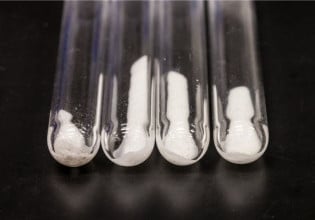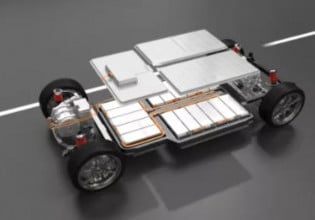Hybrid Converter Simplifies 48V/54 Step-Down Conversion in Data Centers and Telecom Systems
This article highlights Analog Devices' LTC7821-based hybrid converter that has the benefits of both conventional buck converters and charge pumps.
There has been a shift in data center and telecom power system design. Key applications manufacturers are replacing complex, expensive isolated 48 V/54 V step-down converters with more efficient, nonisolated, high-density step-down regulators (Figure 1). Isolation is not necessary in the regulators’ bus converter since the upstream 48 V or 54 V input is already isolated from hazardous ac mains.
For a high input/output voltage application (48 V to 12 V), a conventional buck converter is not an ideal solution because component size tends to be larger. That is, a buck converter must run at a low switching frequency (for example, 100 kHz to 200 kHz) to achieve high efficiency at high input/output voltage. The power density of a buck converter is limited by the size of passive components, especially the bulky inductor. The inductor size can be reduced by increasing the switching frequency, but this reduces converter efficiency because of switching-related losses and leads to unacceptable thermal stress.

Figure 1: A traditional telecom board power system architecture with an isolated bus converter. The isolated bus converter is not necessary in systems where 48 V is already isolated from the ac mains. Replacing the isolated converter with a nonisolated hybrid converter significantly reduces complexity, cost, and board space requirements.
Switched capacitor converters (charge pumps) significantly improve efficiency and reduce solution size over conventional inductor-based buck converters. In a charge pump, instead of an inductor, a flying capacitor is used to store and transfer the energy from input to output. The energy density of capacitors is much higher than inductors—improving power density by a factor of 10 over a buck regulator. However, charge pumps are fractional converters—they do not regulate the output voltage—and are not scalable for high current applications.
An LTC7821-based hybrid converter has the benefits of both conventional buck converters and charge pumps: output voltage regulation, scalability, high efficiency, and high density. A hybrid converter regulates its output voltage with closed-loop control just like a buck converter. With peak current-mode control, it is easy to scale the hybrid converter up for higher current levels (for example, a single-phase design for 48 V to 12 V/25 A to a 4-phase design for 48 V to 12 V/100 A).
All switches in a hybrid converter see half of the input voltage in steady-state operation, enabling the use of low voltage rating MOSFETs to achieve good efficiency. The switching-related losses in a hybrid converter are lower than a conventional buck converter, enabling high-frequency switching.
In a typical 48 V to 12 V/25 A application, efficiency above 97% at full load is attainable with the LTC7821 switching at 500 kHz. To achieve similar efficiency using a traditional buck controller, the LTC7821 would have to operate at a third of the frequency, which results in a much larger solution size. Higher switching frequencies allow the use of smaller inductances, which yield faster transient response and smaller solution size (Figure 2).

Figure 2: Size comparison of a nonisolated buck converter and equivalent 48 V to 12 V/20 A hybrid converter
The LTC7821 is a peak current-mode hybrid converter controller with the features required for a complete solution of a nonisolated, high efficiency, high-density step-down converter for an intermediate bus converter in data centers and telecom systems. The LTC7821’s key features include:
-
Wide VIN range: 10 V to 72 V (80 V abs max)
-
Phase-lockable fixed frequency: 200 kHz to 1.5 MHz
-
Integrated quad ~5 V N-channel MOSFET drivers
-
RSENSE or DCR current sensing
-
Programmable CCM, DCM, or Burst Mode® operation
-
CLKOUT pin for multiphase operation
-
Short-circuit protection
-
EXTVCC input for improved efficiency
-
Monotonic output voltage start-up
-
32-lead (5 mm × 5 mm) QFN package
48 V to 12 V at 25 A Hybrid Converter Featuring 640 W/IN3 Power Density
Figure 3 shows a 300 W hybrid converter using the LTC7821, switching at 400 kHz. The input voltage range is 40 V to 60 V and the output is 12 V at loads up to 25 A. Twelve 10 µF (1210 size) ceramic capacitors are used for each flying capacitor, CFLY, and CMID. The relatively small size 2 µH inductor (SER2011-202ML, 0.75 in × 0.73 in) can be used because of the high switching frequency and the fact that the inductor only sees half of VIN at the switching node (small volt-second).
Figure 3: A 48 V to 12 V/25 A hybrid converter using the LTC7821.
The approximate solution size is 1.45 in × 0.77 in, as shown in Figure 4, resulting in a power density of about 640 W/in3.
Figure 4: Possible layout for a complete bus converter uses the top and bottom sides of the board, requiring only 2.7 cm2 of the topside of the board.
As the bottom three switches always see half the input voltage, 40 V rated FETs are used. An 80 V rating FET is used for the very top switch because it sees the input voltage at the beginning of the precharge of CFLY and CMID during startup (no switching). During steady-state operation, all four switches see half of the input voltage.
Therefore, the switching losses in a hybrid converter are much smaller compared to a buck converter in which all switches see the full input voltage. Figure 5 shows the efficiency of the design. The peak efficiency is 97.6% and the full load efficiency is 97.2%. With high efficiency (low power loss), the thermal performance is very good, as shown in the Figure 6 thermograph. The hot spot is 92°C at an ambient temperature of 23°C with no forced airflow.
Figure 5: Efficiency at 48 V input, 12 V output, and 400 kHz fSW.
Figure 6: Thermograph of the hybrid converter solution in Figure 2.
The LTC7821 implements a unique CFLY and CMID prebalancing technique, which prevents input inrush current during startup. During the initial power-up, the voltage across the flying capacitor CFLY and CMID is measured. If either of these voltages is not at VIN ∕ 2, the TIMER capacitor is allowed to charge up. When the TIMER capacitor voltage reaches 0.5 V, internal current sources are turned on to bring the CFLY voltage to VIN ∕ 2. After the CFLY voltage has reached VIN ∕ 2, CMID is charged to VIN ∕ 2.
The TRACK/SS pin is pulled low during this duration and all external MOSFETs are shut off. If the voltages across CFLY and CMID reach VIN ∕ 2 before the TIMER capacitor voltage reaches 1.2 V, TRACK/SS is released, and a normal soft-start begins. Figure 7 shows this prebalancing period and Figure 8 shows the VOUT soft start at 48 V input, 12 V output at 25 A.
Figure 7: The prebalancing period in the LTC7821 startup avoids high inrush currents.
Figure 8: LTC7821 startup at 48 V input, 12 V output at 25 A (no high inrush current).
1.2 kW Multiphase Hybrid Converter
The easy scalability of the LTC7821 makes it a good fit for high current applications, such as those found in telecom and data centers. Figure 9 shows the key signal connections for a 2-phase hybrid converter using multiple LTC7821s. The PLLIN pin of one LTC7821 and the CLKOUT pin of another LTC7821 are tied together to synchronize the PWM signals.
Figure 9: Connection of key signals of LTC7821 for a 2-phase design
For a design with more than two phases, the PLLIN pin and CLKOUT pin are connected in a daisy chain. Since the clock output on the CLKOUT pin is 180° out of phase with respect to the main clock of LTC7821, even-numbered phases are in phase with each other, while those with odd numbers are antiphase to the evens. A 4-phase, 1.2 kW hybrid converter is shown in Figure 10. The power stage of each phase is identical to the single-phase design in Figure 3.
The input voltage range is 40 V to 60 V and the output is 12 V at load up to 100 A. The peak efficiency is 97.5% and the full load efficiency is 97.1% as shown in Figure 11. The thermal performance is shown in Figure 12. The hot spot is 81°C at an ambient temperature of 23°C with 200 LFM forced airflow. Inductor DCR sensing is used in this design. As shown in Figure 13, current sharing is well balanced among the four phases.
Figure 10: A 4-phase, 1.2 kW hybrid converter using four LTC7821s.
Figure 11: Efficiency for a 4-phase, 1.2 kW design.
Figure 12: Thermograph of the multiphase converter shown in Figure 9.
Figure 13: Current sharing for the multiphase converter shown in Figure 9
Conclusion
The LTC7821 is a peak current-mode hybrid converter controller that enables an innovative, simplified approach to intermediate bus converter implementation in data centers and telecom systems. All switches in a hybrid converter see half of the input voltage, significantly reducing the switching related losses in high input/output voltage applications. Because of this, a hybrid converter can run at 2× to 3× higher switching frequency than a buck converter without compromising efficiency. A hybrid converter can be easily scaled for higher current applications. Lower overall cost and easy scalability differentiate hybrid converters from traditionally isolated bus converters.
About the Authors
Ya Liu received MS degree in the Field of Power Electronics at Virginia Polytechnic Institute and State University. Liu worked as a señior manager of ADI applications engineering.
Jian Li received BS degree in the Fielf of Automation, and MS degree in the Field of Control Theory and Control Engineering at Tsinghua University, then a PhD degree in the Field of Power Electronics at Virginia Technology. Li worked as a señior application manager of ADI with more than 10 years experiences on power electronics including design of high frequency DC/DC converters and voltage regulators for CPU, swiched capacitor converters, battery charger, modeling and control of power converters, digital control techniques, and MPPT for solar PV.
San-Hwa Chee received BSEE and MSEE degree at Oregon State University. Chee worked as a staff scientist at Analog Devices Incorported.
Marvin Macairan (or Jan Marvin Macairan) recevied BS degree in Electrical and Electronics Engineering and MS degree also in Electrical and Electronics Engineering at Californian Polytechnic State University - San Luis Obispo. Macairan worked as an Applications Engineer that is skilled in DC/DC switching regulator design and application support of power modules and ICs, including PCB development and detailed test evaluations.
This article originally appeared in the Bodo’s Power Systems magazine.



















